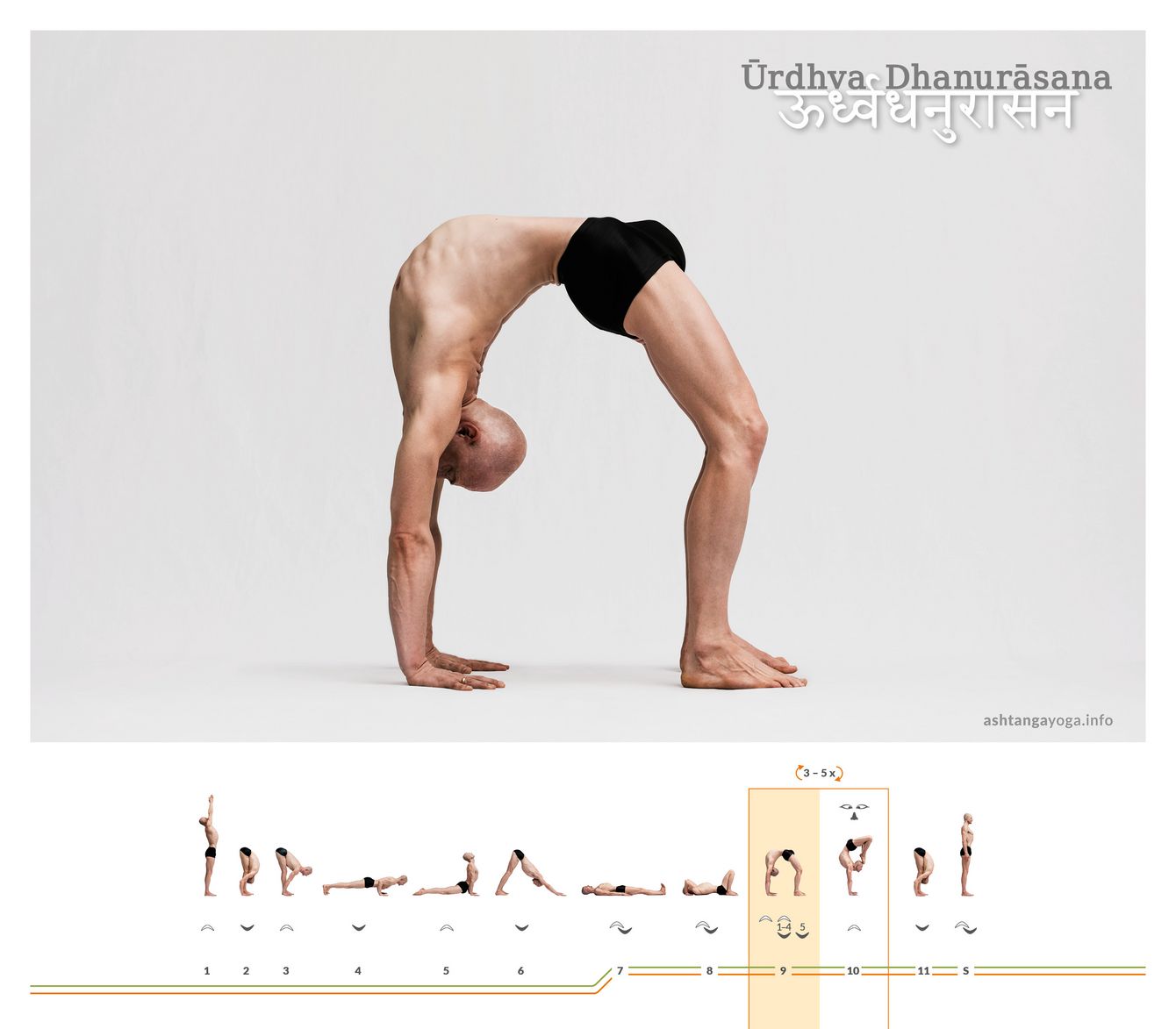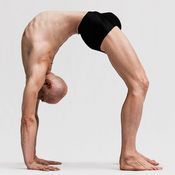

Special: Ūrdhva Dhanurāsana is the final pose of every series. However, it traditionally belongs to the series and not the closing sequence. This is because Ūrdhva Dhanurāsana is still practiced with intense breathing. The closing sequence, on the other hand, is also intended to gradually find a state of calm.
In Traditional Count: Begin directly from the pose of "Downward-Facing Dog" in the previous sequence of movements.
Vinyāsa 7 - Inhalation, Exhalation:
Inhale and push off from the pose of "Downward-Facing Dog." Glide forward and up into a hand balance as you exhale. Lower your legs while keeping them tightly together and extend your arms. Swing your still-extended legs forward between your arms. Use this motion to lie flat on your back while maintaining tension in your body.
Vinyāsa 8 - Inhalation, Exhalation:
Inhale and lift your legs and arms vertically towards the ceiling. Place your feet as close to your pelvis as possible and your hands as close to your ears as possible.
Try: In this Vinyāsa, press your shoulders and pelvis firmly into the ground to maximize the backbend in your torso. Carry this deep backbend into the next Vinyāsa. Position your hands so that your fingers point clearly to the sides. This hand position supports the movement of your shoulder blades. To create freedom of movement in the sacroiliac joint, stand on the balls of your feet instead of the entire feet.
Vinyāsa 9 - Inhalation, 5 breaths, Inhalation:
Inhale and lift your pelvis by pressing your feet into the ground. Extend your arms and lift your shoulders. Try to actively stretch your arms and legs. Stay here until the fifth exhalation and one more inhalation.
Note: Activate your legs by imagining straightening your knees and pushing the floor away with your feet. However, the more important aspect in preparation for the next Vinyāsa is the activity of your arms. Push your arms consciously, starting from the shoulder blades, and lengthen them while turning your armpits toward each other. This facilitates the movement of the shoulder blades and protects your shoulder joint. Expand your chest and gaze toward your own feet. You will notice more weight on your hands, and you'll be ready for Vinyāsa 10.
Vinyāsa 10 - Exhalation:
Shift your weight onto your hands as you inhale. Your feet will lift off the ground. Pull them toward your head as you dive forward through your arms with your heart center. This is how you find balance on your hands.
Vinyāsa 9 and 10 - Three to five repetitions:
Lower yourself back down into Vinyāsa 9 and lift yourself up into Vinyāsa 10 three to five times. Always stay in Ūrdhva Dhanurāsana until the fifth exhalation, which is at the end of Vinyāsa 9.
Vinyāsa 11:
Finally, lower your feet on the other side with an exhale. This brings you into the standing forward bend.
Samasthitiḥ:
One inhalation and exhalation bring you to the neutral pose Samasthitiḥ.
In traditional counting: Proceed directly to the sequence of movements for the next pose from here.
Effect: Ūrdhva Dhanurāsana, the upward-facing bow, completes your practice like a small ritual. A deep backbend followed by an intense forward bend creates balance in your body.
Fotograf: Richard Pilnick - www.richardpilnick.com


 Dr. Ronald Steiner
Dr. Ronald Steiner
Messages and ratings